Submit Payment. *Click* You’ve just place your order online. Yes – that brand new Nutri-Something-I-Didn’t-Know-I-Needed blender is on sale and you just happened to be the lucky number 1,498,012th person to order one. Lucky you. You wait with bated breath every afternoon rushing home to see if you can perhaps – by some stroke of God-given luck – beat the man in the brown truck (UPS guy) to your door. Maybe… just maybe, you’ll see that box sitting their at your doorstep in all its glory just waiting to blend up all that goodness inside your fridge into a delicate puree that would make even the refined palate of Martha Stuart drool in envy.
But there’s nothing. No blender of awesomeness. No box. No brown truck. Just a bank statement saying you’ve dished out the green stuff for the ever elusive goods. What gives?! You write an email – timidly yet respectfully requesting more information on your would-be blender. Days pass and you’ve not heard a word. You try again – this time, their call line. A 25 minute wait?! Yeah – no. You’ve got stuff to do and things to blend. You send them a Facebook message. Still – nothing.
Your would-be-fandom slowly deteriorates into a growing hatred fueled by distrust. You held up your end of the bargain! A simple email would have sufficed. A confirmation. A tracking number. A “thanks for the money” text. Anything. But nope – you’re stuck in a world of no response.
^ This scenario is most restoration companies and their agent, property management, and home owner clients. Let me explain – first with the agents.
Agent John Smith (original right?) met you, the restoration marketer, the other day when you happened to stop by to invite their office to an upcoming CE Class covering the titillating topic of a water loss. Agent John takes an immediate liking to you and grabs your business card on the way out. “I’ll give you a try” he says after explaining how his experience with [insert competing restoration company here] has left him and his insureds with a lot to be wanting. Yes – you’ve scored. Cha-ching. Start warming up your end zone dance routine.
The next day, a loss is taken. It was from Agent John’s insured. Says the agent recommended your company. You get the commission and you’re out. Not your problem anymore, right? That’s mitigation’s problem. You take your money to the nearest blender store and the circle of life continues (ok – scratch the blender part… I’m getting carried away). But you’ve committed the cardinal sin of selling-after-the-sale. We work in a weird industry and your calling card after a claim is following up with the agent, the home owner, the property manager – whomever. YOUR JOB AS A MARKETER IS TO FOLLOW UP.
Stop looking at me with those puppy dog eyes. I’ll tell you how to come up with the perfect followup packet.
How to Give the Perfect Followup Packet
What You’ll Need:
- Pictures – yes. Get to whatever project manager is on that claim and get pictures from them. It isn’t hard – most PM’s are required to grab pictures anyways. Who cares if the job is nowhere near completion – we just want pictures.
- A Comment Card – you’ll need to check in with the homeowner to see how they think the project is going. By this point in the loss, your company hasn’t had a chance to really mess anything up, so if your communication is on point, this referral should be nothing but music to your referring client’s ears. Make a quick call to the insured and jot it down in an easy-to-read word document. Bam – that’s all you need.
- A Thank You Card – hey, this guy is giving you a shot and you are going to need to thank him. Hand written (yes – I’m talking to even you sloppy writers) thank you card signed by yours truly with your business card neatly tucked in and a quick note saying “Hey – if you need anything, let me know.”
- Make It Personal. You know the referring client better than I do. What did he have on his desk? Pictures of his dog? Throw in a dog toy. A signed baseball? Grab a box of cracker jacks. This is not a bribe so all of you who are screaming “TREASON” can hush. This is the thing that’ll make Agent John remember your company for the next loss and make him remember you for all eternity. Keep it personal and don’t spend over $5 to $10 bucks.
Next Step: Delivery.
This should really be done no less than a week after the loss. Hey – it’s a followup and your referring client will probably want to know what his insured is doing and how things are going. He put his name on the line for you – make him look good for it. That’s the biggest compliment you can pay anyone. Have the pictures pre-printed neatly in a manila folder with your thank you card nicely tucked inside. Attach a second business card using a paperclip to the outside of the folder and write the claimant’s last name on the outside. Proceed to put memorable thank you give on top of folder and hand deliver to referring client. Sit back. Watch the referrals roll in.
Now the followup doesn’t stop there, my friend. Wash, rinse, and repeat every month (this time without the thank you card or the gift) (or every other month) until the job has reached completion. If there are issues, fix them and let your referring client know what the issues were and how they were resolved. If you let your mind venture back to our blender-blunder scenario you’ll remember what our sentiments were – it definitely wasn’t “no news is good news.” If you want an update – whether good or bad – so do your clients.
An added benefit of “the followup” is that it allows you to have an excuse to visit referring clients. So often I hear agents and property managers moan and groan when referencing “too persistent” restoration marketers who interrupt their busy schedules to sit down and “chat”. I roll my eyes in agreement every time – it is all about VALUE ADDED, people! Come on! Only stop by a client office if you have something to offer them – a followup, an invitation, a letter of recommendation from a client, hell, a birthday cake for their dog, Fido!
So go forth. Create your ultimate followup packet. and Followup.
FAQ
What is follow-up?
Follow-up refers to the act of checking in with a person or business after an initial interaction, such as a meeting or sales pitch, to maintain communication and build a relationship.
Why is follow-up important in business?
Follow-up is important in business because it helps build and maintain relationships with clients or customers, increases the chances of closing a sale or securing a deal, and demonstrates professionalism and attentiveness.
What are some common reasons why people fail to follow up?
Common reasons why people fail to follow up include forgetting, being too busy or overwhelmed, lack of organization or prioritization, and fear of rejection or failure.
How can individuals or businesses improve their follow-up habits?
Individuals or businesses can improve their follow-up habits by setting reminders or using a follow-up system, prioritizing follow-up as an essential part of the sales or relationship-building process, and developing a mindset of persistence and resilience.
What are some benefits of effective follow-up?
Benefits of effective follow-up include increased trust and rapport with clients or customers, improved sales and revenue, and enhanced reputation and credibility in the industry.
How can businesses use technology to improve follow-up?
Businesses can use technology such as CRM software, email marketing tools, and social media platforms to automate and streamline follow-up processes, track customer interactions, and personalize communications.
What are some best practices for follow-up communication?
Best practices for follow-up communication include personalizing the message, addressing any concerns or questions raised by the customer, offering valuable information or resources, and maintaining a consistent and regular follow-up schedule.
How can businesses measure the effectiveness of their follow-up efforts?
Businesses can measure the effectiveness of their follow-up efforts by tracking metrics such as response rates, conversion rates, and customer feedback, and using this data to optimize their follow-up strategies.
Can following up be seen as pushy or intrusive?
Following up can be seen as pushy or intrusive if done excessively or without regard for the customer’s preferences or boundaries, but when done in a respectful and professional manner, it is generally seen as a positive and proactive approach to building relationships and closing deals.
What are some resources or tools for improving follow-up skills?
Resources and tools for improving follow-up skills include books on sales and relationship building, online courses or webinars, and networking events or mentorship programs.

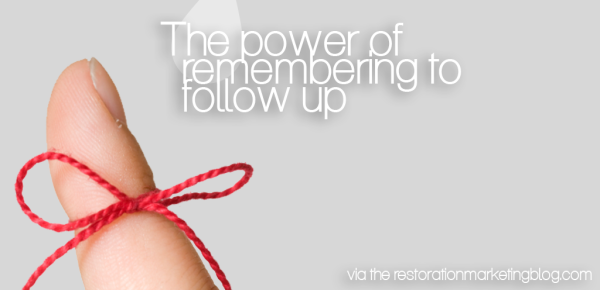





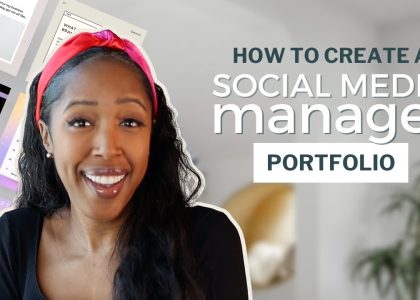
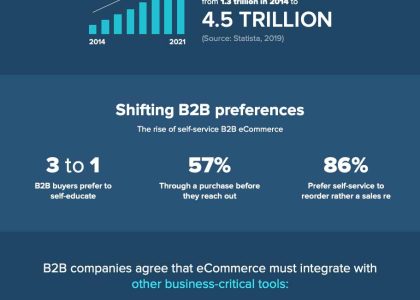
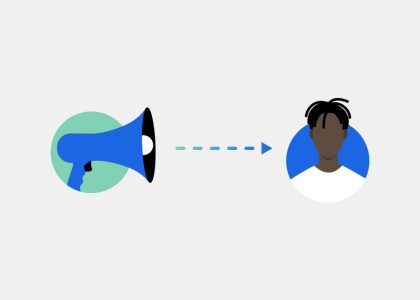
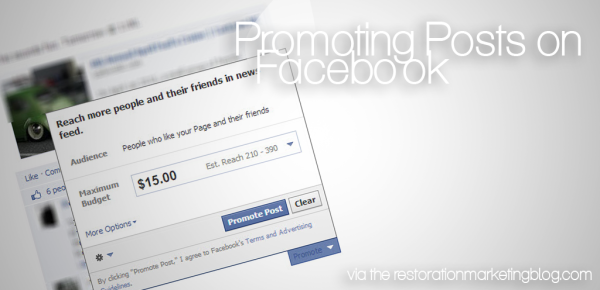
I found this article to be incredibly helpful in understanding the importance of following up with customers. The author provides great insights and actionable tips for businesses looking to improve their customer retention rates.
This article is a game-changer for anyone in the restoration industry. It highlights the importance of following up with clients and prospects and provides actionable tips for doing so effectively. A must-read!
This article on the power of following up is a must-read for anyone in the restoration industry. The author provides valuable insights into the importance of consistent communication with clients and the positive impact it can have on your business.
As someone who has struggled with follow-ups in the past, I found this article incredibly helpful. The author does a great job of explaining why follow-ups are so critical and offers practical advice for integrating them into your business strategy.
As someone who runs a small business, I’m always looking for ways to improve my customer outreach. This article really hit the mark for me; it’s full of practical suggestions that are easy to apply, and the writing is clear and concise.
I found this article to be incredibly helpful in improving my follow-up practices. The tips and strategies provided are practical and easy to implement, and I’ve already seen an increase in customer satisfaction and retention.
As someone who struggles with staying organized and on top of follow-ups, this article was a game-changer for me. The author offers actionable steps to streamline the process and make it more effective, resulting in better relationships with clients.
I appreciated how the author emphasized the power of personalization in follow-up communications. It’s so easy to send generic messages, but taking the time to tailor each email or call to the customer’s specific needs and interests can really make a difference in their overall satisfaction with your brand.
The Power of Remembering to Follow Up is a must-read for anyone in sales, marketing, or customer service. The author’s insights into the psychology of follow-ups and their impact on customer relationships are invaluable.
I was impressed by the data-backed arguments the author made in support of follow-up strategies. Seeing the numbers really drove home just how critical it is to stay in touch with customers and build strong relationships over time.
The author does an excellent job of highlighting the benefits of following up with clients, both for their satisfaction and for the growth of your business. I highly recommend this article to anyone in the restoration industry looking to improve their communication skills.
This article is a great reminder of the importance of staying in touch with customers and prospects. The author provides real-world examples and tips for creating a follow-up system that works for your business.
I was impressed with the level of detail and research presented in this article. The author not only explains why follow-up is important but also provides data-backed evidence to support their claims. This article is a valuable resource for anyone in the restoration industry.
If you’re looking to improve your customer retention and boost your bottom line, you need to read this article. The author’s advice on how to make follow-ups a habit and leverage technology to streamline the process is spot-on.
Overall, I think this article is a must-read for anyone interested in marketing or customer service. It’s engaging, informative, and ultimately leaves you feeling motivated to start implementing some of the ideas presented.